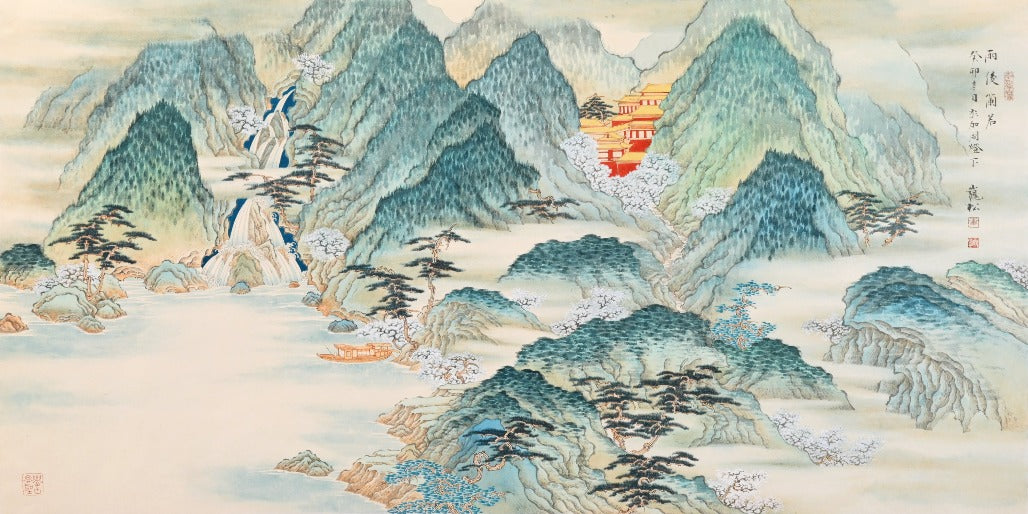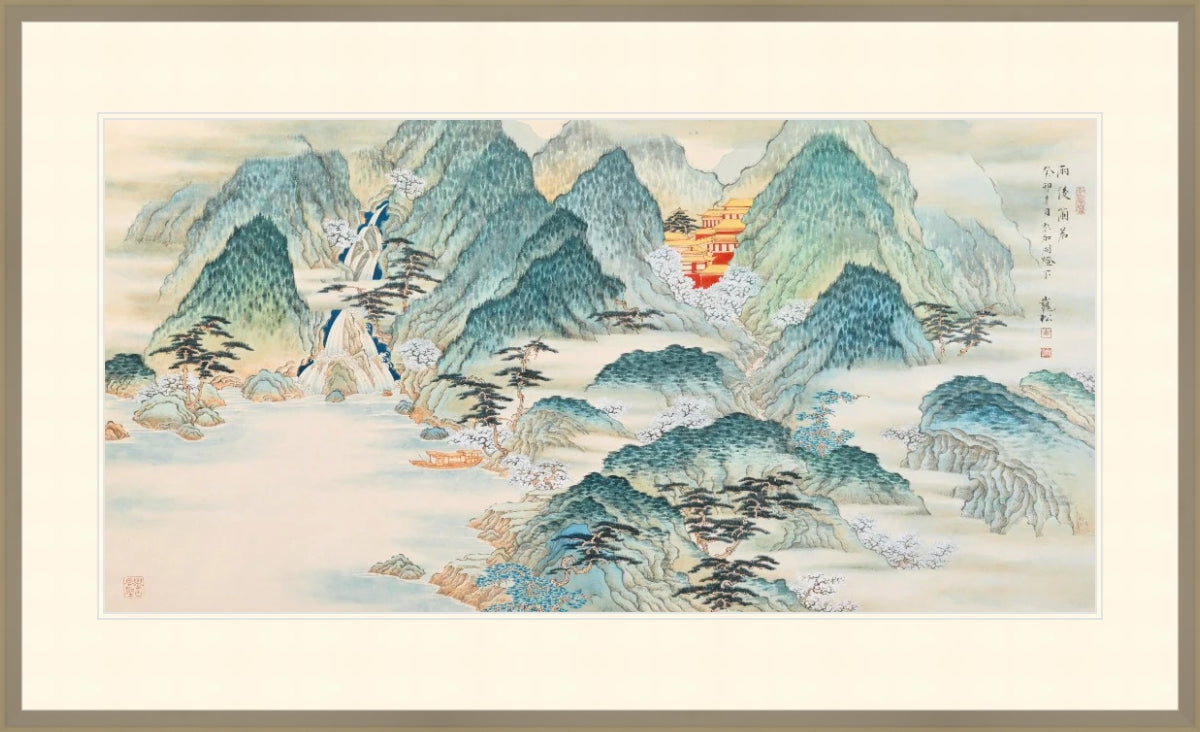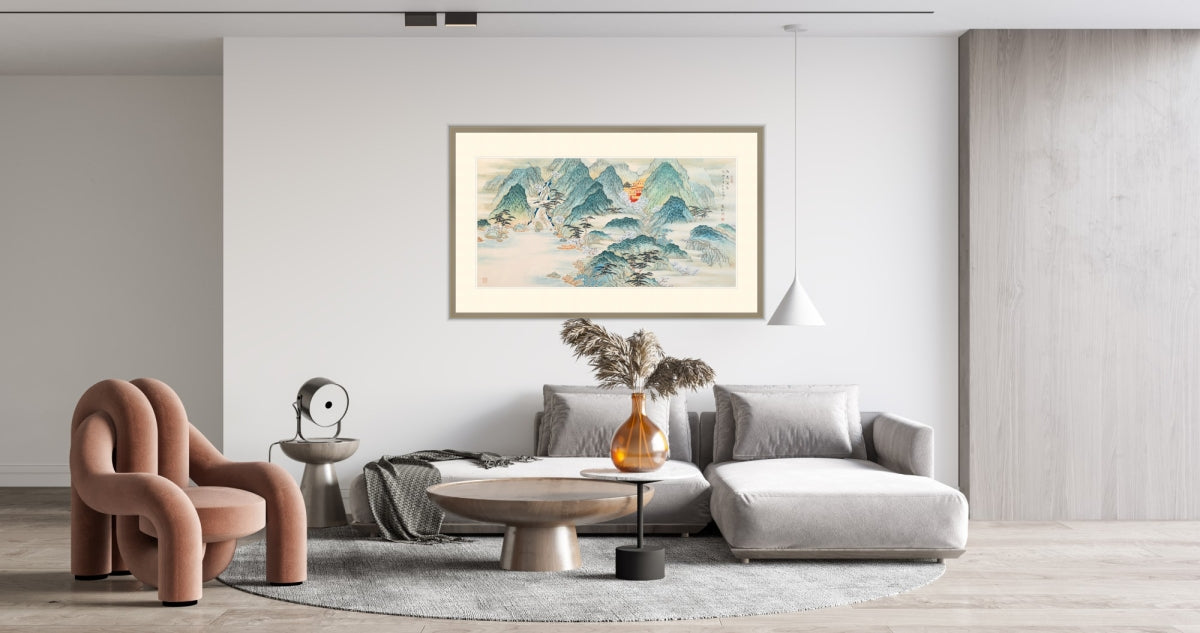1
/
of
4
雨后兰若 The Temples after The Rain
- Regular price
-
$20,600.00 - Regular price
-
- Sale price
-
$20,600.00
雨后兰若
Artist: Li, Weisong 李巍松
Media: Chinese Painting on Rice Paper
Size: 39 x 20 in. (100 x 50 cm)
“兰若”梵语又称“阿兰若”,佛教用语,指供修道人禅修的寂静处,和梵刹、精舍混称,也泛指寺庙。
画雨后景色,要有一种朦胧梦幻的感觉,似真似幻,让人迷恋。表现雨后山水,很多画家喜欢用北宋米芾父子的米点皴。通过水墨点汇聚成山,表现雨后云烟弥散的景色。米点皴在使用过程中,常常结合泼墨、积墨等技法,画出迷茫的效果,李巍松在采用米点皴的同时,亦加入南宋画家赵伯骕的风格元素。使得画面莹润清丽,更具风神。
题跋释文: 癸卯冬月于加国等下。巍松
“兰若” is a Sanskrit term in Buddhism, also known as "阿兰若," referring to a quiet place for monks to meditate and cultivate, commonly used interchangeably with terms like 梵刹 (Buddhist monastery) and 精舍 (hermitage). It is a general reference to Buddhist temples.
When painting a scenery after rain, one should aim for a dreamy and ethereal feeling, creating an illusion that is both real and unreal, captivating the viewer. To depict post-rain landscapes, many artists favor the "rice dotting" technique introduced by the father-son duo Mi Fu and Mi You from the Northern Song Dynasty. This technique involves using ink dots to create mountains, portraying the scene where rain clouds disperse. The rice dotting technique, often combined with techniques like splashing ink and building up ink, produces a hazy effect. Li Weisong, while employing the rice dotting technique, also incorporates stylistic elements from Zhao Bosu, a Southern Song Dynasty painter, resulting in a picture that is both lustrous and graceful, exuding a distinctive charm.
Artist: Li, Weisong 李巍松
Media: Chinese Painting on Rice Paper
Size: 39 x 20 in. (100 x 50 cm)
“兰若”梵语又称“阿兰若”,佛教用语,指供修道人禅修的寂静处,和梵刹、精舍混称,也泛指寺庙。
画雨后景色,要有一种朦胧梦幻的感觉,似真似幻,让人迷恋。表现雨后山水,很多画家喜欢用北宋米芾父子的米点皴。通过水墨点汇聚成山,表现雨后云烟弥散的景色。米点皴在使用过程中,常常结合泼墨、积墨等技法,画出迷茫的效果,李巍松在采用米点皴的同时,亦加入南宋画家赵伯骕的风格元素。使得画面莹润清丽,更具风神。
题跋释文: 癸卯冬月于加国等下。巍松
“兰若” is a Sanskrit term in Buddhism, also known as "阿兰若," referring to a quiet place for monks to meditate and cultivate, commonly used interchangeably with terms like 梵刹 (Buddhist monastery) and 精舍 (hermitage). It is a general reference to Buddhist temples.
When painting a scenery after rain, one should aim for a dreamy and ethereal feeling, creating an illusion that is both real and unreal, captivating the viewer. To depict post-rain landscapes, many artists favor the "rice dotting" technique introduced by the father-son duo Mi Fu and Mi You from the Northern Song Dynasty. This technique involves using ink dots to create mountains, portraying the scene where rain clouds disperse. The rice dotting technique, often combined with techniques like splashing ink and building up ink, produces a hazy effect. Li Weisong, while employing the rice dotting technique, also incorporates stylistic elements from Zhao Bosu, a Southern Song Dynasty painter, resulting in a picture that is both lustrous and graceful, exuding a distinctive charm.
Couldn't load pickup availability
-
Hurry, only 1 item left in stock!



雨后兰若 The Temples after The Rain
- Regular price
-
$20,600.00 - Regular price
-
- Sale price
-
$20,600.00




